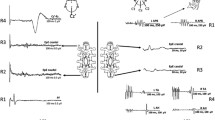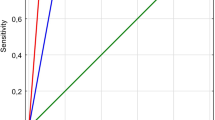Abstract
Purpose
The combined recordings of epidural-(D wave) and muscle motor evoked potentials (m-MEPs) have been proposed in many studies in intramedullary spinal cord tumour (IMSCT) surgery, although not all agree. Furthermore, the usefulness of the intraoperative monitoring of motor systems using these methods in other types of spine surgery has not yet been clearly confirmed. The aim of this study is to test the impact of intraoperative D wave on the monitorability and motor outcome in spine surgery.
Methods
Intraoperative recording of posterior tibial nerve somatosensory potentials, lower limb m-MEPs (LLm-MEPs) and epidurally recorded D wave caudally to the surgical level was attempted in a total of 103 spine and spinal cord surgeries (23 IMSCT, 55 extramedullary spinal cord tumours and 25 myelopathies).
Results
There was a 97.1 %, overall monitorability where at least 1 of the 3 modalities was applicable in 100 surgical procedures. Baseline LLm-MEPs were recorded bilaterally in 85 cases and unilaterally in 11. A caudal D wave was recorded in 97 cases. Transient, or persistent intraoperative modifications occurred in 14/23 IMSCT, 5/55 extramedullary spinal cord tumours and in 2/25 myelopathies. The presence of a persistent stable caudal D wave was predictive of a good motor outcome even when the LL-MEPs were absent and/or when lost during surgery.
Conclusions
Not only is intraoperative D wave recording to be considered mandatory in IMSCT surgery but it should also be attempted in other types of spine/spinal cord surgeries.




Similar content being viewed by others
References
Boyd SG, Rothwell JC, Cowan JM, Webb PJ, Morley T, Asselman P, Marsden CD (1986) A method of monitoring function in corticospinal pathways during scoliosis surgery with a note on motor conduction velocities. J Neurol Neurosurg Psychiatry 49:251–257
Hicks RG, Burke DJ, Stephen JP (1991) Monitoring spinal cord function during scoliosis surgery with Cotrel-Dubousset instrumentation. Med J Aust 154:82–86
Burke D, Hicks R, Stephen J, Woodforth I, Crawford M (1992) Assessment of corticospinal and somatosensory conduction simultaneously during scoliosis surgery. Electroencephalogr Clin Neurophysiol 85:388–396
Pechstein U, Cedzich C, Nadstawek J, Schramm J (1996) Transcranial high-frequency repetitive electrical stimulation of recording myogenic motor evoked potential with the patient under general anesthesia. Neurosurgery 1996(39):335–344
Jones SJ, Harrison R, Koh KF, Mendoza N, Crockard HA (1996) Motor evoked potential monitoring during spinal surgery: responses of distal limb muscles to transcranial cortical stimulation with pulse trains. Electroencephalogr Clin Neurophysiol 100:375–383
Kothbauer KF, Deletis V, Epstein FJ (1998) Motor-evoked potential monitoring for intramedullary spinal cord tumor surgery: correlation of clinical and neurophysiological data in a series of 100 consecutive procedures. Neurosurg Focus 4:1–9
Deletis V, Sala F (2008) Intraoperative neurophysiological monitoring of the spinal cord during spinal cord and spine surgery: a review focus on the corticospinal tracts. Clin Neurophysiol 119:248–264
Patton HD (1954) Amassian VE Single and multiple unit analisys of cortical stage of pyramidal tract activation. J Neurophysiol 17:345–363
Deletis V, Sala F. Corticospinal tract monitoring with D- and I-waves from the spinal cord and muscle MEPs from limb muscles. In: Daube JR, Mauguiére F (eds) Handbook of clinical neurophysiology. Volume 8. Intraoperative Monitoring of Neural Function [Volume Editor Nuwer MR].Elsevier, 2008, pp.235-251
Kothbauer K, Deletis V, Epstein FJ (1997) Intraoperative spinal cord monitoring for intramedullary surgery: an essential adjunct. Pediatr Neurosurg 26:247–254
Cioni B, Meglio M, Rossi GF (1999) Intraoperative motor evoked potentials monitoring in spinal neurosurgery. Arch Ital Biol 137:115–126
Deletis V (1999) Intraoperative neurophysiological monitoring. In: MacLeone D (ed) Pediatric neurosurgery: surgery of the developing nervous system. 3rd edn. W.B. Saunders, Philadelphia, pp 1204–1213
Sala F, Palandri G, Basso E, Lanteri P, Deletis V, Faccioli F et al (2006) Intraoperative motor evoked potential monitoring improves outcome after surgery of intramedullary spinal cord tumor: a historical control study in 50 patients. Neurosurgery 58:1129–1143
Quiñones-Hinojosa A, Lyon R, Zada G, Lamborn KR, Gupta N, Parsa AT, McDermott MW, Weinstein PR (2005) Changes in transcranial motor evoked potentials during intramedullary spinal cord tumor resection correlate with postoperative motor function. Neurosurgery 56:982–993
Hyun SJ, Rhim SC (2009) Combined motor and somatosensory evoked potential monitoring for intramedullary spinal cord tumor surgery: correlation of clinical and neurophysiological data in 17 consecutive procedures. Br J Neurosurg 23:393–400
Calancie B, Molano MR (2008) Alarm criteria for motor-evoked potentials: what’s wrong with the “presence-or-absence” approach? Spine (Phila Pa 1976) 33:406–414
Deletis V (2002) Intraoperative neurophysiology and methodologies used to monitor the functional integrity of the motor system. In: Deletis V, Shils JL (eds) Neurophysiology in neurosurgery. Academic Press, New York, pp 25–51
MacDonald DB (2006) Intraoperative motor evoked potentials monitoring: overview and update. J Clin Monit Comput 20:347–377
McCormick PC, Torres R, Post KD, Stein BM (1990) Intramedullary ependymoma of the spinal cord. J Neurosurg 72:525–532
MacDonald DB, Janusz M (2002) An approach to intraoperative neurophysiological monitoring of thoracoabdominal aneurysm surgery. J Clin Neurophysiol 2002(19):43–54
Acknowledgments
This study would not have been possible without the expert technical assistance of Alessandro Borio, Marta Giacobbi, Sonia Marmolino, Maurizio Mogno, Domenico Serpella, Angela Palmitessa and Daniela Milani. The authors thank Mrs. Barbara Wade for her helpful suggestions during the English editing of the manuscript.
Conflict of interest
None.
Author information
Authors and Affiliations
Corresponding author
Rights and permissions
About this article
Cite this article
Costa, P., Peretta, P. & Faccani, G. Relevance of intraoperative D wave in spine and spinal cord surgeries. Eur Spine J 22, 840–848 (2013). https://doi.org/10.1007/s00586-012-2576-5
Received:
Revised:
Accepted:
Published:
Issue Date:
DOI: https://doi.org/10.1007/s00586-012-2576-5




